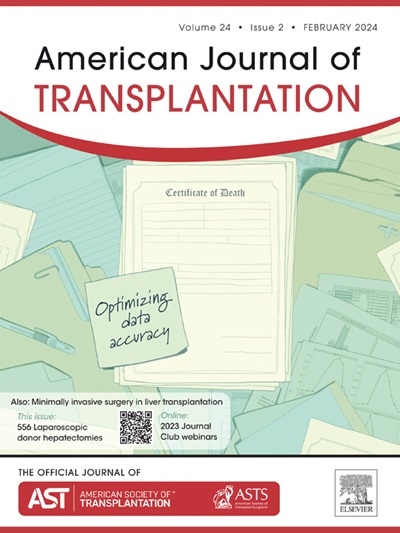Off-Label Use of Alemtuzumab, Belatacept, and Rapamycin in Kidney Transplantation - Long-Term Real-World Experience.
IF 8.2
2区 医学
Q1 SURGERY
引用次数: 0
Abstract
Conventional immunosuppressive regimens in kidney transplantation continue to pose significant challenges, largely due to their reliance on calcineurin inhibitors (CNI) and corticosteroids. These challenges have driven the search for alternative regimens to minimize toxicity and preserve long-term graft function. In this study, we present real-world data utilizing a CNI-free regimen that makes use of the synergistic effects of costimulation blockade and mTOR inhibition. We retrospectively analyzed 106 kidney recipients from 2016 to 2024 who received alemtuzumab induction, followed by de novo belatacept and sirolimus maintenance therapy (ABR regimen). Patient and graft survival were 100% at one year and 96 and 97% respectively at 5 years. At 3 and 5 years, median GFR was 64mL/min/1.73m2 (IQR 54-75) and 62mL/min/1.73m2 (54-74), respectively. The rate of rejection in the first year was 6.6%. Ninety-six patients (91%) avoided treatment with CNIs during the follow-up period. Alemtuzumab and belatacept were well tolerated, but 44% of patients discontinued sirolimus, typically due to sirolimus-related side-effects remedied with conversion to mycophenolate and prednisone. These results inform and support the study of the ABR protocol, or similar costimulation blockade-based regimens, in pursuit of non-CNI-based therapies for kidney transplant recipients.阿仑单抗、贝拉他普和雷帕霉素在肾移植中的适应症外使用-长期真实世界经验。
传统的免疫抑制方案在肾移植中仍然面临重大挑战,主要是由于它们对钙调磷酸酶抑制剂(CNI)和皮质类固醇的依赖。这些挑战促使人们寻找替代方案,以尽量减少毒性并保持移植物的长期功能。在这项研究中,我们利用无cni方案,利用共刺激阻断和mTOR抑制的协同效应,提供了真实世界的数据。我们回顾性分析了2016年至2024年106例接受阿仑单抗诱导的肾受体,随后接受了新的贝拉他普和西罗莫司维持治疗(ABR方案)。患者和移植物1年生存率为100%,5年生存率分别为96%和97%。在3年和5年,中位GFR分别为64mL/min/1.73m2 (IQR 54-75)和62mL/min/1.73m2(54-74)。第一年的拒绝率为6.6%。96例患者(91%)在随访期间避免使用CNIs治疗。Alemtuzumab和belatacept耐受性良好,但44%的患者停用西罗莫司,通常是由于西罗莫司相关的副作用,转而使用霉酚酸盐和泼尼松进行补救。这些结果为ABR方案的研究提供了信息和支持,或类似的基于共刺激阻断的方案,以追求肾移植受者的非cni治疗。
本文章由计算机程序翻译,如有差异,请以英文原文为准。
求助全文
约1分钟内获得全文
求助全文
来源期刊
CiteScore
18.70
自引率
4.50%
发文量
346
审稿时长
26 days
期刊介绍:
The American Journal of Transplantation is a leading journal in the field of transplantation. It serves as a forum for debate and reassessment, an agent of change, and a major platform for promoting understanding, improving results, and advancing science. Published monthly, it provides an essential resource for researchers and clinicians worldwide.
The journal publishes original articles, case reports, invited reviews, letters to the editor, critical reviews, news features, consensus documents, and guidelines over 12 issues a year. It covers all major subject areas in transplantation, including thoracic (heart, lung), abdominal (kidney, liver, pancreas, islets), tissue and stem cell transplantation, organ and tissue donation and preservation, tissue injury, repair, inflammation, and aging, histocompatibility, drugs and pharmacology, graft survival, and prevention of graft dysfunction and failure. It also explores ethical and social issues in the field.

 求助内容:
求助内容: 应助结果提醒方式:
应助结果提醒方式:


